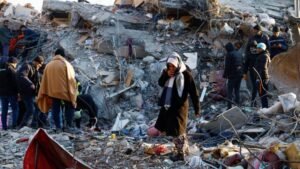Erdogan’s Response to Turkey Earthquake faces criticism over rescue efforts

Introduction:
On January 24, 2021, Turkey experienced a significant seismic event, as a powerful 6.8 magnitude earthquake struck the eastern region of Elazig. This disaster caused extensive destruction, claimed numerous lives, and left countless individuals injured. The aftermath of the earthquake has brought to light both the resilience of the affected communities and the challenges faced by the government’s relief efforts.
A Day of Tragedy and Destruction:
The Unforgettable Earthquake of January 24, 2021
The earthquake, measuring 6.8 on the Richter scale, unleashed widespread destruction in Elazig, leaving no stone unturned. Homes were reduced to rubble, and many families were torn apart. The event also sparked a race against time as rescue teams struggled to reach those trapped beneath the debris.
Swift Actions and Presidential Reassurances:
President Erdogan’s Visit to the Stricken Region
Just two days after the disaster, Turkish President Recep Tayyip Erdogan visited the affected area. During his visit, he offered his condolences and met with survivors, promising to do everything in his power to assist those in need. Despite his reassurances, criticism began to mount, with some questioning the speed and effectiveness of the relief operations.
Challenges Faced by the Deliverance Operation:
Insufficient Resources and Communication Breakdown
A Critical Analysis of the Relief Efforts
The relief brigades faced several challenges that hindered their operations. Limited resources, including funds, equipment, and manpower, posed obstacles to effectively reaching those in distress. Additionally, a lack of clear communication from the government about the progress of rescue operations further fueled frustrations among the affected communities.
Voices of Dissent and Growing Frustrations:
Public Outcry and Blame-Game Dynamics
As days turned into weeks, the public’s dissatisfaction grew. Many pointed fingers at President Erdogan, accusing him of not doing enough to support victims and rescue workers. The outcry stemmed from the perceived inadequate allocation of resources and insufficient coordination among the various entities involved in the rescue efforts.
Rebuilding Lives and Lessons Learned:
Government’s Pledge for Recovery and Future Preparedness
Amidst the criticism, President Erdogan pledged to support affected families and initiate the process of rebuilding the devastated areas. He also committed to conducting an in-depth investigation into the causes of the earthquake, with the aim of preventing similar disasters in the future. The government’s response highlighted the importance of preparedness and effective communication during times of crisis.
A Path Towards Healing and Resilience:
Community Resilience and International Aid
Despite the challenges faced, the affected communities showcased remarkable resilience. Neighbors came together to offer support, and international aid began pouring in to assist with relief efforts. The disaster underscored the significance of unity and cooperation in times of adversity.
Lessons for the Future:
Enhancing Disaster Preparedness and Response
The earthquake in Elazig serves as a sobering reminder of the importance of disaster preparedness and rapid response. Governments must ensure they have the necessary resources, infrastructure, and communication strategies in place to effectively manage crises of this magnitude. The lessons learned from this tragedy can serve as a blueprint for improving future disaster responses.
Conclusion:
A Call for Swift and Effective Response
The earthquake that struck Turkey’s Elazig region on January 24, 2021, brought about devastation and heartache for many. President Erdogan’s visit and promises of assistance demonstrated concern, yet the challenges faced by relief operations highlighted the need for better preparedness and coordination. The journey towards recovery will require concerted efforts, effective resource allocation, and open communication. As Turkey strives to heal and rebuild, the lessons learned from this disaster can pave the way for a more resilient future

